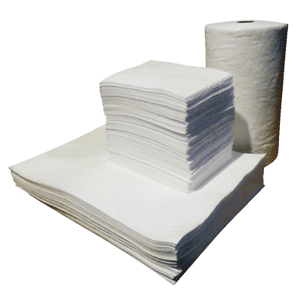White sorbents have been used to mop up spills in the rain for decades. They can be very effective and make up a significant number of the products we provide. They are designed to absorb oil, not water.
As you’re considering sorbents, here is more information and a few stats to help you fully understand their capabilities.
What are White Sorbents?
Before we dig into the stats, let’s do some groundwork. White sorbents are made from synthetic fibers including polypropylene and polyester. They are lightweight and dust-free. We manufacture four types:
 Standard Polypropylene. They have open fiber construction that draws hydrocarbon-based fluids into the center of the pads/rolls, while repelling water.
Standard Polypropylene. They have open fiber construction that draws hydrocarbon-based fluids into the center of the pads/rolls, while repelling water. - Fine Fiber. This is a soft, super-sorbent fiber that resembles tissue paper. They absorb quickly, remove sheen, and grip cement floors.
- White Dimpled. Our thermal bonding process ties down loose fibers. They are also perforated, allowing you to use only the amount you need for each spill.
- Spunbound. This manufacturing process yields high tensile strength and durability, yet doesn’t limit its absorption capabilities.
All our white sorbents absorb oil, repel water, and because they’re white, they show exactly where the oil has been absorbed.
Absorbent Capacity
This is measured in gallons or liters. It’s the total amount of hydrocarbon fluids that the material will absorb. Using ASTM F726-81 standards, it is measured using medium weight motor oil (20W). You can typically see this listed as Absorption/Package.
Sorbency Ratio
This is the ratio of liquid absorption versus the dry weight of the sorbent. It basically tells you how much material you’ll need for a given spill. Here’s the formula:
Sorbency = (Wet Weight — Dry Weight) / Dry Weight
Hydrophobic
The primary benefit of white sorbents is that they repel water and absorb the oil. This is particularly critical in the rain. This measures the material’s ability to repel water.
Static Resistance
At low temperatures and low humidity, the danger of sparks and resulting ignition of the hydrocarbons rises. We manufacture sorbents specifically designed for these conditions. Of course, in the rain you don’t have to worry about low humidity.
Cost vs. Gallons Absorbed
This is a measure of the cost effectiveness of the material you’re using. Note, too, that materials with higher absorption capacity not only minimize the amount of material needed but also the amount of material that must be disposed.
Labor Costs
There are two major sources of labor costs: deployment and disposal. The sorbent type and form can directly impact both these costs. Ideally, the materials can be quickly deployed, don’t need to be replaced repeatedly, and can be cleaned up and disposed just as quickly.
That’s a short list of effectiveness stats and factors. In addition, there are a number of other items that impact sorbent effectiveness. They include the type of fluid (oil, paraffin, diesel, benzene, alcohols, toluene, trichloroethane, esters), the fluid viscosity, surface tension, ambient temperature, and even the polarity of the fluid.
How We Can Help
While any spill can be challenging, rain adds yet another element to the mix. With that in mind, we’ve been working on breakthrough solutions including our Spilltration™ line of products. If you’re not familiar with them, I recommend my blog post, “A Better Oil Solution for the Rain.”
Spilltration™ products filter the water from the hydrocarbon fluids, instead of repelling water, like white sorbents. As a result, disposal costs are greatly reduced as you need far less material. Plus, because of the need for less material, storage capacity is greatly reduced and deployment is much quicker. There’s more at “Key Tools for Cleaning Up an Oil Spill in the Rain.”
You can see Spilltration® in action at Spilltration® Oil Spill Clean-Up.
With the Spilltration® line of tools we have solutions for every type of spill or leak. They include spill kits, shammy towels, as well as husky strips, rugs, and pads. Further, the Spill Boa offers not only incredible spill control but remarkably lower storage space requirements.
Want to Learn More?
We’d be delighted to discuss how we can help you prepare for oil spills in the rain. Use our contact page, or call us at 888-653-7509.


